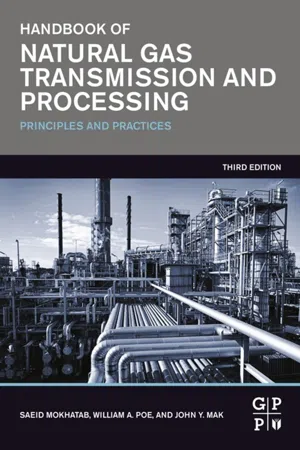
Handbook of Natural Gas Transmission and Processing
Principles and Practices
- 628 pages
- English
- ePUB (mobile friendly)
- Available on iOS & Android
Handbook of Natural Gas Transmission and Processing
Principles and Practices
About this book
Written by an internationally-recognized author team of natural gas industry experts, the third edition of Handbook of Natural Gas Transmission and Processing is a unique, well-documented, and comprehensive work on the major aspects of natural gas transmission and processing. Two new chapters have been added to the new edition: a chapter on nitrogen rejection to address today's high nitrogen gases and a chapter on gas processing plant operations to assist plant operators with optimizing their plant operations. In addition, overall updates to Handbook of Natural Gas Transmission and Processing provide a fresh look at new technologies and opportunities for solving current gas processing problems on plant design and operation and on greenhouse gases emissions. It also does an excellent job of highlighting the key considerations that must be taken into account for any natural gas project in development.- Covers all technical and operational aspects of natural gas transmission and processing in detail.- Provides pivotal updates on the latest technologies, applications and solutions.- Offers practical advice on design and operation based on engineering principles and operating experiences.
Frequently asked questions
- Essential is ideal for learners and professionals who enjoy exploring a wide range of subjects. Access the Essential Library with 800,000+ trusted titles and best-sellers across business, personal growth, and the humanities. Includes unlimited reading time and Standard Read Aloud voice.
- Complete: Perfect for advanced learners and researchers needing full, unrestricted access. Unlock 1.4M+ books across hundreds of subjects, including academic and specialized titles. The Complete Plan also includes advanced features like Premium Read Aloud and Research Assistant.
Please note we cannot support devices running on iOS 13 and Android 7 or earlier. Learn more about using the app.
Information
Natural Gas Fundamentals
Abstract
Keywords
Composition; Natural gas origin; Phase behavior; Properties; Transportation methods1.1. Introduction
1.2. Natural gas history
Table of contents
- Cover image
- Title page
- Table of Contents
- Copyright
- Disclaimer
- Dedication
- Contributor
- About the Authors
- Foreword
- Preface to the Third Edition
- Endorsements for the Third Edition
- Chapter 1. Natural Gas Fundamentals
- Chapter 2. Raw Gas Transmission
- Chapter 3. Basic Concepts of Natural Gas Processing
- Chapter 4. Phase Separation
- Chapter 5. Condensate Production
- Chapter 6. Natural Gas Treating
- Chapter 7. Natural Gas Dehydration
- Chapter 8. Natural Gas Liquids Recovery
- Chapter 9. Sulfur Recovery and Handling
- Chapter 10. Nitrogen Rejection
- Chapter 11. Natural Gas Compression
- Chapter 12. Sales Gas Transmission
- Chapter 13. Gas Processing Plant Automation
- Chapter 14. Gas Processing Plant Operations
- Chapter 15. Dynamic Simulation of Gas Processing Plants
- Chapter 16. Real-Time Optimization of Gas Processing Plants
- Chapter 17. Maximizing Profitability of Gas Plant Assets
- Chapter 18. Gas Plant Project Management
- Appendix 1. Conversion Factors
- Appendix 2. Standard Gas Conditions
- Appendix 3. Physical Properties of Fluids
- Index